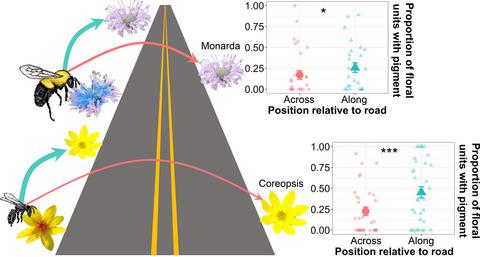当前位置:
X-MOL 学术
›
J. Appl. Ecol.
›
论文详情
Our official English website, www.x-mol.net, welcomes your
feedback! (Note: you will need to create a separate account there.)
Roads pose a significant barrier to bee movement, mediated by road size, traffic and bee identity
Journal of Applied Ecology ( IF 5.0 ) Pub Date : 2021-05-10 , DOI: 10.1111/1365-2664.13884 Gordon Fitch 1 , Chatura Vaidya 1 , Lori Lach
中文翻译:

道路对蜜蜂的移动构成了重大障碍,受道路规模、交通和蜜蜂身份的影响
更新日期:2021-06-02
Journal of Applied Ecology ( IF 5.0 ) Pub Date : 2021-05-10 , DOI: 10.1111/1365-2664.13884 Gordon Fitch 1 , Chatura Vaidya 1 , Lori Lach
Affiliation

|
- Roads are a major driver of environmental stress, yet we know surprisingly little about how roads impact the movement of insect pollinators, and consequent pollination.
- We investigated the influence of roads on pollinator movement and pollination by examining patterns of pigment transfer between focal plants of two species, Coreopsis verticillata and Monarda fistulosa. We asked whether roads reduced pigment transfer, and what characteristics of roads were important in driving this reduction. We also evaluated whether pollinator assemblage differed between species, and if this mediated the effect of roads on pigment transfer.
- Plants across a road from a pigment-added plant received significantly less pigment than plants on the same side of the road. This effect was stronger for coreopsis than for monarda. The mean body size of visitors to coreopsis was significantly smaller than that of visitors to monarda, suggesting that smaller bees are more limited by roads.
- Road width was the best predictor of pigment transfer, with a smaller effect of traffic volume; further research is needed to fully disentangle the effects of different road characteristics. Roadside habitat had little influence on pigment transfer, and roadside plants did not receive significantly less pigment than plants in contiguous habitat.
- Synthesis and applications. This study demonstrates that roads pose substantial barriers to bee movement, reducing pollen flow between plants located across roadways from one another. Road characteristics, particularly width and traffic volume, mediated this effect, as did bee size. Our results suggest that the effects of roads on pollinators and pollination can be mitigated by many of the same design strategies currently being implemented to reduce human traffic accidents, offering the opportunity for win–win scenarios.
中文翻译:

道路对蜜蜂的移动构成了重大障碍,受道路规模、交通和蜜蜂身份的影响
- 道路是环境压力的主要驱动因素,但我们对道路如何影响昆虫传粉媒介的运动以及随之而来的授粉知之甚少。
- 我们通过检查两种植物(金鸡 菊和Monarda fistulosa)的焦点植物之间的色素转移模式,研究了道路对传粉媒介运动和授粉的影响。我们询问道路是否减少了颜料转移,以及道路的哪些特征对推动这种减少很重要。我们还评估了授粉媒介组合是否因物种而异,以及这是否介导了道路对色素转移的影响。
- 与添加了色素的植物隔一条马路的植物比道路同一侧的植物获得的色素少得多。金鸡菊的这种效果比 monarda 更强。金鸡菊游客的平均体型明显小于 monarda 游客的平均体型,这表明较小的蜜蜂更受道路限制。
- 道路宽度是颜料转移的最佳预测指标,对交通量的影响较小;需要进一步研究以充分解开不同道路特性的影响。路边栖息地对色素转移几乎没有影响,路边植物吸收的色素并不比邻近栖息地的植物少。
- 合成与应用。这项研究表明,道路对蜜蜂的运动构成了巨大的障碍,减少了彼此穿过道路的植物之间的花粉流动。道路特征,特别是宽度和交通量,调节了这种影响,蜜蜂的大小也是如此。我们的研究结果表明,道路对传粉媒介和授粉的影响可以通过目前正在实施的许多相同的设计策略来减轻,以减少人类交通事故,为双赢的场景提供机会。











































 京公网安备 11010802027423号
京公网安备 11010802027423号